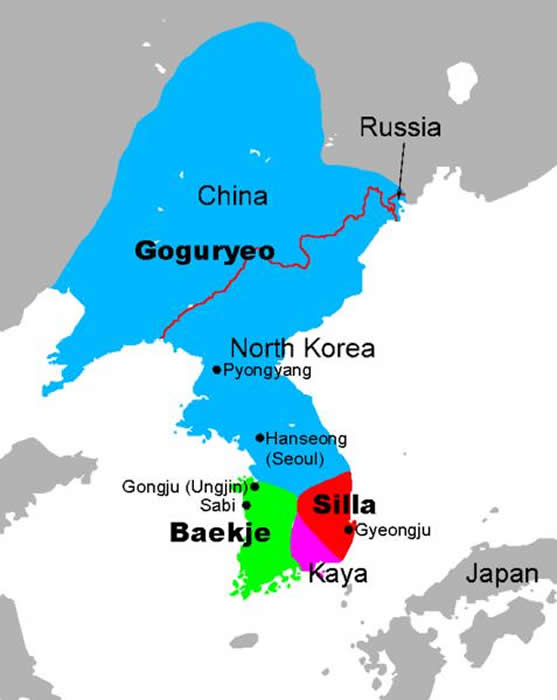 Goguryeo Kingdom
Goguryeo Kingdom

(Text by Duane R. Hurst © 2013)
Click on a link to view its information and pictures.
|
GOGURYEO LINKS: Significant Event: Memorial of Gwanggaeto Main Cities: Jolbon; Gungnae; Pyongyang Time: 37 BC - 668 AD Language: Korean Personage: Gwanggaeto; Jumong; Taejo Religion: Buddhism; Korean Religion Related Country: China; North Korea; South Korea Brief History: I have included only a few items concerning the history of this kingdom. A good source for more details can be found on Wikipedia or in history books. EARLY YEARS: Circa 2nd century BC, the Yemaek people from Manchuria established the Buyeo (aka Puyo) Kingdom. In 86 BC, Dongbuyeo (Eastern Buyeo) became a separate kingdom (86 BC - 410 AD). Tradition holds that Jumong fled from Dongbuyeo to found the Goguryeo Kingdom at Jolbon in 37 BC. He later became known as King Dongmyeong. |
|
|
GOGURYEO-WEI WAR:
In 242 AD, Goguryeo troops under King Dongcheon raided territory of the Chinese kingdom of Wei (aka Chao Wei) at Xi'anping (modern Dandong). This precipitated a series of invasions between 244 and 245 AD. General Guanqiu Jian led 10,000 soldiers against King Dongcheon, who led 20,000 cavalry and infantry from his capital at Hwando. Despite having superior numbers, Guanqiu Jian triumphed in the Battle of Liangkou (modern Xinbin County). Wei forces then destroyed the mountain fortress of Hwando in 244 AD. They resettled thousands of people to Wei territory and greatly weakened Goguryeo. ZENITH OF POWER: Goguryeo rebuilt Hwando and within 70 years renewed incursions into Lelang, Liaodong and Xuantu areas. King Daeso of Dongbuyeo attacked King Yuri of Goguryeo. Yuri's son, Daemusin, became king and retaliated by killing Daeso and conquering Dongbuyeo. In 372 AD, King Sosurim converted to Buddhism and made it the state religion. King Gwanggaeto (391-412 AD) brought Goguryeo to its zenith. By 404 AD, he reportedly seized 64 walled cities, 1,400 villages and the entire Liaodong Peninsula. He absorbed the Buyeo Kingdom and seized much of the Baekje Kingdom. Gwanggaeto also forced the early kingdom of Silla into protectorate status. His triumphs were carved on a memorial stele. COLLAPSE: During the 6th and 7th centuries AD, Goguryeo often fought with the Chinese dynasties of Sui and Tang. In 551 AD, Baekje and Silla allied to attack Goguryeo. Baekje unsuccessfully attacked first, while Silla troops arrived to seize the Han River valley in 553 AD. King Seong of Baekje was incensed and retaliated against Silla. Silla troops captured him in battle and executed him. Silla allied with Emperor Taizong against Goguryeo in 646 AD. Taizong personally led an army that captured many fortresses on the Lioning Peninsula. However, the general commanding Goguryeo forces at Ansi (modern Anshan) stymied further progress and Taizong withdrew. After Taizong's death, Chinese forces returned in 661 and 662 AD but general Yeon Gaesomun successfully stopped them. In 660 AD, the Baekje Kingdom (allied with Goguryeo) fell to the Silla-Tang alliance. Following Yeon's death and a crisis within Goguryeo, Tang troops crossed the Liao River in 667 AD. Joint Silla and Chinese captured Pyongyang and ended Goguryeo rule. Angry that the Tang refused to share Goguryeo's territory, Silla fomented opposition that resulted in the Silla-Tang Wars (670-676 AD). |
|
|
© Page Publisher: Duane R. Hurst
|


